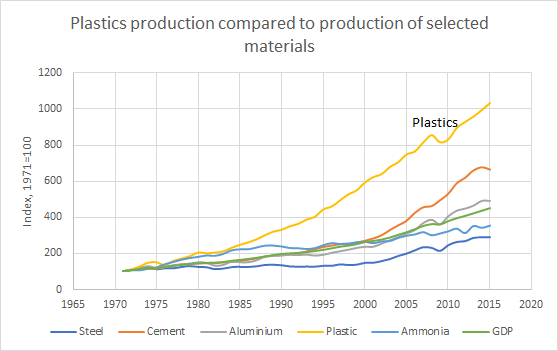By Andy May
It came up in conversation: How much oil and gas goes into plastics and fertilizer production? It turns out the IEA has a 2018 report on this very topic. They have a separate 2020 report on total energy used in 2019. The reports contain some interesting graphs and data. Below is a comparison of total energy use in 1973 and 2018, from the Key World Energy Statistics 2020 Report.

Figure 1. Comparison of total energy used in 1973 and 2018 by primary energy source.
In the 45 years between 1973 and the end of 2018, the use of oil dropped significantly and most of this energy was replaced by coal, natural gas, and nuclear. Wind and solar (part of “other”) increased a little, but the increase makes little difference. Biofuels, mainly wood burning, dropped nearly as much as “other” increased.
In The Future of Petrochemicals IEA 2018 report, we find that about 14% of the world’s oil and 8% of the world’s natural gas are used as feedstocks for producing petrochemicals. The petrochemical industry produces thousands of products we use every day. They include plastics, fertilizer, clothing, electronic devices, medical equipment, medicine, tires, solar panels, wind turbine blades, batteries, and insulation. The report points out that the demand growth for plastics and fertilizer are outpacing the demand growth for steel, aluminum, and cement. Petrochemical product demand has nearly doubled since 2000 and the U.S. and Europe use twenty times as much plastic and ten times as much fertilizer as India, Indonesia and other developing countries on a per-capita basis. This means the explosion in growth will not abate anytime soon. Figure 2 compares the growth in plastic production to the growth in other areas and GDP since 1971.

Figure 2. Global plastics production compared to the production of steel, cement, aluminum, ammonia, and to global GDP. Each quantity is shown as a dimensionless index where 1971=100.
Of the nearly 10 million b/d growth in demand for oil projected for 2030, the petrochemical sector accounts for more than 33%. The sector also accounts for more than 7% of the expected increase in demand for natural gas. Petrochemicals are the largest component of projected demand growth for oil and gas until 2030.
The conclusions are obvious.
- The growth in solar and wind powered electricity makes no difference, the impact on fossil fuel use is lost in round-off.
- Petrochemicals are critical for our lives today and they are growing faster than total energy use.
- Coal, oil and natural gas are here for a long time to come. They will probably be replaced someday as a source of energy, but the only candidate on the horizon is nuclear.
Author

Biography
Andy May is a writer, blogger, and author living in The Woodlands, Texas; and enjoys golf and traveling in his spare time. He is the author of two books on climate change issues and one on Kansas history. Andy is the author or co-author of seven peer-reviewed papers on various geological, engineering and petrophysical topics. He retired from a 42-year career in petrophysics in 2016. You can find many of his posts on the popular climate change blog Wattsupwiththat.com, where he is an editor. His personal blog is andymaypetrophysicist.com.
